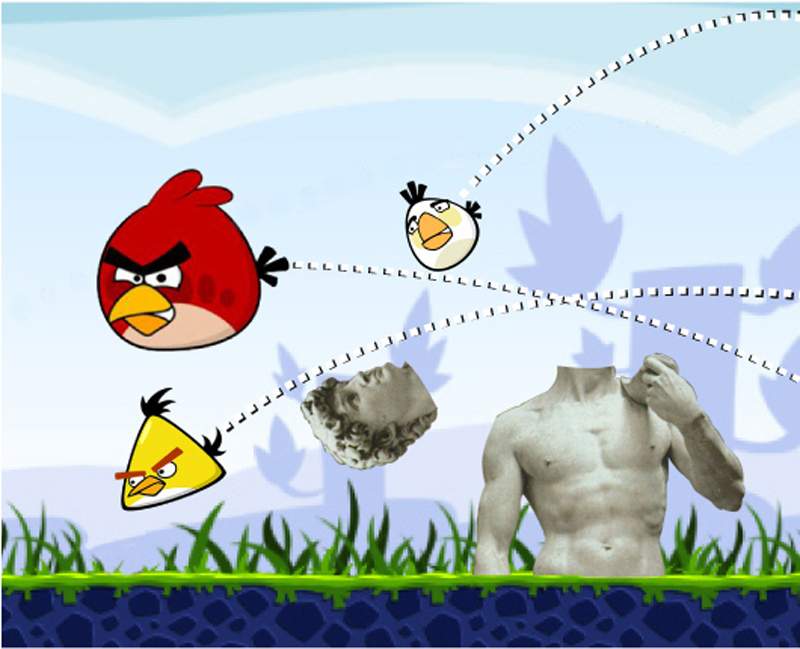
Planning a Museum App for “Away Time”—Connect Online and On-site Experiences
When thinking of games for museums, it’s hard not to let your mind think of hits like “Angry Birds,” which had 200 million downloads by May 2011 [i]. Players worldwide spend 200 million minutes (=380 years) on the game each day [ii]. This demonstrates that people do love to play well-crafted, “snack food” style games that have optimized game play mechanics (easy to learn, hard to master). They are addictive and fun. Should museums try to replicate or imitate this?
Probably not.
But what can museums do to tap into this extraordinary phenomenon and use it to connect with their audiences?
This makes me wonder why the museum online and on-site experiences are so separated.
I have reviewed 50+ museum apps. Most of them provide great information about exhibits or artists. They have up-to-date general information (address, hours, admission fees, etc.) and content that can be consumed in short periods of time (snack style), and they have links to social media sites for more information [iii]. They are mainly self-contained experiences that make no requirement to be at the museum in order to use or enjoy them. Most online educational games and interactive online features created by museums are designed to be played only once, taking from 30 seconds to 15 minutes, with no real expectation that players will return to the game or continue playing [iv].
This makes me wonder why the museum online and on-site experiences are so separated.
Museums are actually in a great position to link online and on-site experiences.
Museums are actually in a great position to link online and on-site experiences. They could combine what they do well—serving visitors on-site—with sticky game elements online. Nothing is more valuable for a kid than seeing, looking, smelling, or holding a fossilized dinosaur bone in his/her hands. This is an experience that museums know how to deliver and the online world cannot.
Consider the fact that there are millions of kids logging into commercially driven online game worlds, e.g., Club Penguin, Webkinz, and Moshi Monsters on a daily basis. These environments provide children with an opportunity to engage in spontaneous play with friends. They can socialize and have experiences that most adults find hard to imagine. The kids, for their part, don’t actually see much difference between their virtual playground and a physical one they might visit. They treat their virtual friends similarly to the kids they meet in the real world.
The kids, for their part, don’t actually see much difference between their virtual playground and a physical one they might visit.
What if museums could harness the stickiness of online worlds, creating long-lasting games for players to explore, collect, investigate, and then connect this game experience directly back to the experience of the real-world museum? This is what museum game creators should be trying to accomplish.
Away Time
Using the “Away Time” concept is a good place to start. It meets visitors halfway—when they are playing apps on smart devices or computers—and actively directs them back to the museum to claim real rewards. It feels good when you “push” achievements to Facebook and you know your friends “like” them. It would be even better if you could “show off” your reward, even if it’s as simple as “a sparkly paper crown” or “a shiny museum pin” that can be worn during your visit to the actual museum. These “Away Time” games can be designed to bring audiences into the real galleries to see and experience real objects directly connected to gratifying gaming experiences while they are “away” from the museum. This is the challenge.
Online games are a medium for fantasy, while museums are a gateway—with tangible objects—to an amazing inspirational world.
The boundaries between the virtual world and the real world blur as playtime happens simultaneously in both online and on-site settings. Online games are a medium for fantasy, while museums are a gateway—with tangible objects—to an amazing inspirational world.
I’d like to begin a conversation around looking at “Away Time”—where millions of users are playing apps and using the elements of sticky games—as a mechanism to lure game players back into the museum to see real objects and hear real stories about them—as can only be experienced in museums. We must actively work to make this connection.
Please share your ideas for this with us.

Dr. Herminia Din is Associate Professor of Art Education, Department of Art at the University of Alaska, Anchorage. Prior to joining the faculty at the University of Alaska Anchorage in 2003, Dr. Din worked for seven years in the museum field designing the “Young at Art” Program at the Hirshhorn Museum and Sculpture Garden (Smithsonian Institution) and developing the first educational website for the Metropolitan Museum of Art. She was also the web producer at the Children’s Museum of Indianapolis, Indiana, the largest children’s museum in the US.
Dr. Din serves as a board member of the Media and Technology Committee for the American Association of Museums, and it was her inspired presentation at the AAM 2012 conference about museum game apps that inspired me to ask her to author this post for Tronvig Group. I feel that her insights are critically important to the future relevance and success of museums as they seek to engage with kids on terms increasingly set by the kids themselves.
References
[i] D. Hinkle, “Angry Birds Hits 200 Million Download Mark,” Joystiq, May 18, 2011
Illustration by Tronvig


Ask for help.
We are kind, thorough and ready when you are. You just need to ask.